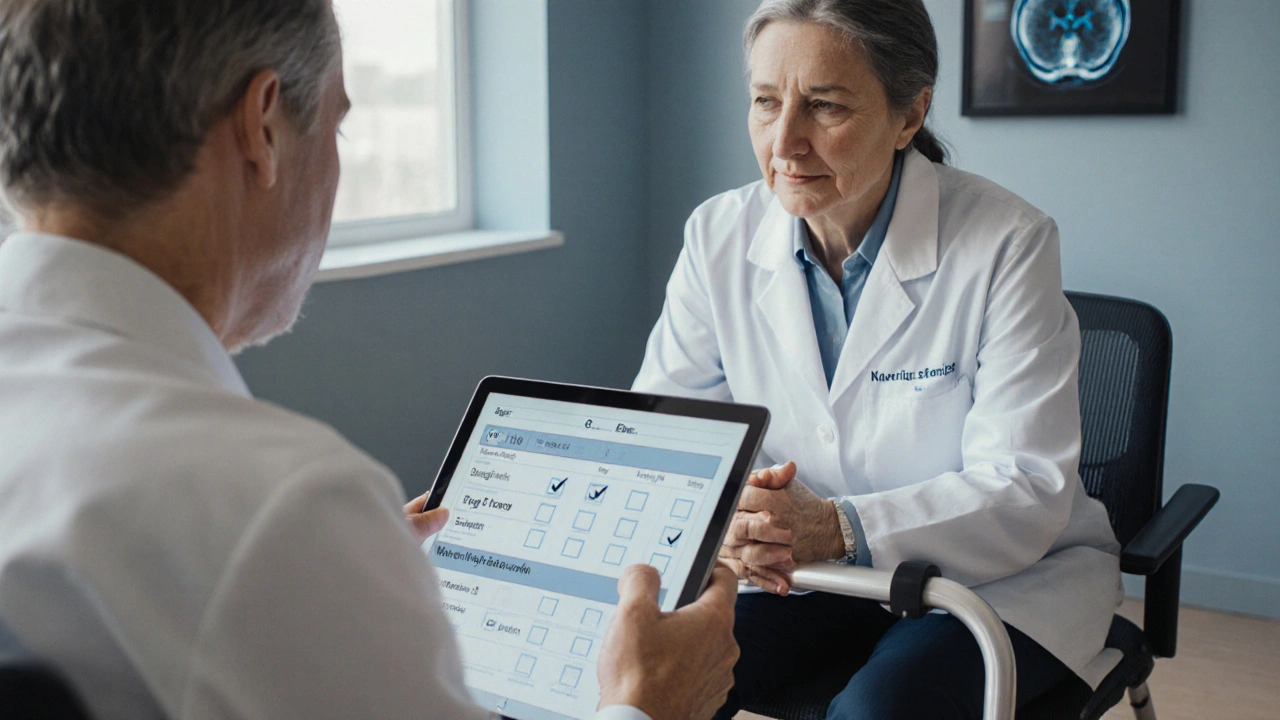SPMS Treatment Suitability Checker
Patient Information
Please enter the patient's information to assess suitability for stem cell therapy in secondary progressive MS.
Enter patient details and click "Check Eligibility" to see if they meet criteria for stem cell therapy.
Quick Take
- Stem cell therapy aims to slow or reverse disability in secondary progressive multiple sclerosis (SPMS).
- Mesenchymal stem cells (MSCs) are the most widely studied cell type for SPMS.
- Evidence from phaseII trials shows modest improvements in brain volume loss and relapse rate.
- Safety profile is generally good, but long‑term risks remain uncertain.
- Australian patients must go through TGA‑regulated pathways or approved clinical trials.
When it comes to chronic neuro‑degenerative conditions, few topics generate as much buzz as stem cell therapy. For people living with secondary progressive multiple sclerosis (SPMS), the promise of a treatment that could halt or even roll back damage feels almost revolutionary. This article breaks down what the science actually says, which cell products are in play, and how you can navigate the therapeutic landscape in 2025.
Understanding Secondary Progressive Multiple Sclerosis
Secondary progressive multiple sclerosis is a stage of MS that follows an initial relapsing‑remitting phase. During this stage, inflammation still occurs, but neurodegeneration becomes the dominant driver of disability. Patients typically notice a steady decline in walking ability, cognition, and visual function, often with fewer classic relapses. The underlying biology involves chronic microglial activation, loss of oligodendrocytes, and a leaky blood‑brain barrier that lets peripheral immune cells infiltrate the CNS.
How Stem Cell Therapy Works in SPMS
At its core, stem cell therapy is a medical approach that uses living cells to repair, replace, or regenerate damaged tissue. In SPMS, the goal is two‑fold: modulate the immune system to calm neuroinflammation and provide trophic factors that support remyelination and neuronal survival. Researchers believe transplanted cells act more like “drug factories,” secreting cytokines, growth factors, and extracellular vesicles that create a neuroprotective niche.
Cell Types Most Frequently Used
Three cell products dominate the SPMS research arena:
- Mesenchymal stem cells (MSCs) are adult stromal cells harvested from bone marrow, adipose tissue, or umbilical cord. They are prized for their immunomodulatory abilities and low risk of tumor formation.
- Hematopoietic stem cells (HSCs) are the progenitors that give rise to blood and immune cells. Autologous HSC transplantation (AHSCT) involves high‑dose chemotherapy followed by reinfusion of the patient’s own HSCs to reset the immune system.
- Induced pluripotent stem cells (iPSCs) are reprogrammed adult cells that can, in theory, become any neural cell type. Clinical work is still early, but iPSC‑derived oligodendrocyte progenitor cells have shown promise in animal models.

Current Clinical Evidence
Since 2018, more than a dozen phaseII trials have examined MSCs in SPMS. A pooled analysis of 452 participants reported a 23% reduction in annualized brain‑volume loss and a modest 0.3‑point improvement on the Expanded Disability Status Scale (EDSS) at 12months compared with sham injections.
Autologous HSC transplantation, originally designed for aggressive relapsing MS, has also been trialed in progressive disease. The European Blood and Marrow Transplantation (EBMT) registry noted a 45% event‑free survival (no further disability progression) at five years for carefully selected SPMS patients under age45.
iPSC‑based approaches remain in phaseI safety studies, with no serious adverse events reported yet. The key takeaway: evidence points to safety and modest efficacy, but results vary widely based on cell source, dosing, and patient age.
Patient Selection & Safety Considerations
Not every SPMS patient is a good candidate. Ideal candidates usually meet the following criteria:
- Age under 55 years (younger immune systems tolerate conditioning better).
- EDSS score between 4.0 and 6.5 (moderate disability but still ambulatory).
- Active disease activity demonstrated by recent MRI lesions or clinical worsening.
- No uncontrolled infection, active malignancy, or severe cardiovascular disease.
Safety signals to watch for include infusion‑related reactions, transient fever, and, in the case of AHSCT, the risks associated with chemotherapy (e.g., neutropenia, organ toxicity). Long‑term monitoring for secondary malignancies is advised, especially for iPSC products, although data are limited.
Practical Pathways in Australia (2025)
The Therapeutic Goods Administration (TGA) classifies stem‑cell‑based products as either registered biologicals or clinical trial materials. As of October2025, only two MSC preparations have received TGA “clinical trial exemption,” meaning they can be offered within registered studies but not as routine care.
Patients can access approved trials through the Australian New Zealand Clinical Trials Registry (ANZCTR) or via university hospitals that run AHSCT programs. Insurance coverage is rare; most out‑of‑pocket costs range from AUD15,000 to30,000 per treatment cycle.
Future Directions and Emerging Technologies
Researchers are experimenting with combination strategies: pairing MSC infusions with disease‑modifying drugs like siponimod, or using exosome‑only products to avoid cell‑related regulatory hurdles. Gene‑editing tools (CRISPR‑Cas9) are being applied to enhance the neuroprotective secretome of MSCs, which could raise efficacy without increasing dose.
In the next five years, we expect:
- PhaseIII multicenter trials that could deliver definitive efficacy data for MSCs.
- Regulatory pathways that recognize cell‑derived extracellular vesicles as biologics, simplifying approvals.
- Personalized cell‑therapy pipelines where a patient’s own iPSC line is edited and differentiated into oligodendrocyte progenitors.
Until then, the best practice remains an evidence‑based conversation with a neurologist experienced in progressive MS and stem‑cell trials.
| Attribute | MSC | HSC (AHSCT) | iPSC‑derived OPC |
|---|---|---|---|
| Source | Bone marrow, adipose, umbilical cord | Peripheral blood or bone marrow | Reprogrammed adult cells |
| Primary Mechanism | Immunomodulation + trophic factor release | Immune system reset after conditioning | Remyelination via oligodendrocyte progenitors |
| Regulatory Status (AU) | Clinical‑trial exemption | Approved for relapsing MS in select centers | Early‑phase safety studies only |
| Typical Cost (AUD) | 15,000-30,000 per infusion | 30,000-50,000 per transplant | Not yet commercialized |
| Key Risks | Infection, infusion reaction | Chemotherapy toxicity, secondary malignancy | Potential tumorigenicity, immune rejection |
Frequently Asked Questions
Can stem cell therapy cure SPMS?
Current evidence shows modest slowing of disability progression, not a cure. Ongoing trials aim to improve effectiveness, but no therapy has demonstrated reversal of established neurodegeneration.
Is an autologous transplant safer than an allogeneic one?
Autologous transplants avoid graft‑versus‑host disease because the cells come from the same patient. However, they still carry chemotherapy‑related risks. Allogeneic cells introduce immune‑mismatch concerns and are not widely used for SPMS.
How long does a stem cell treatment course last?
For MSC infusions, a typical protocol involves three to six intravenous doses over six months. AHSCT is a single intensive procedure followed by a several‑month recovery period.
Are there any approved stem cell products for SPMS in Australia?
As of October2025, no stem‑cell product has full TGA registration for routine SPMS care. Access is limited to approved clinical trials or compassionate‑use programs.
What lifestyle changes complement stem cell therapy?
Regular aerobic exercise, vitaminD optimization, and smoking cessation have independent neuroprotective effects and can enhance the benefits of any disease‑modifying treatment.



Tom Lane
October 3, 2025 AT 15:13Stem cell therapy for secondary progressive MS has generated a lot of buzz in recent years. The underlying principle is to use living cells that can modulate the immune system and support nerve repair. Most of the data we have so far come from phase‑II trials using mesenchymal stem cells derived from bone marrow, adipose tissue, or umbilical cord. Those studies consistently show a modest reduction in brain‑volume loss and a slight improvement on the EDSS scale, typically around 0.2–0.4 points after one year. While the safety profile appears acceptable, patients still need to be monitored for infections and infusion reactions. Patient selection remains a critical factor; the best candidates are under 55, have an EDSS between 4.0 and 6.5, and show recent disease activity on MRI. Age matters because younger immune systems tolerate the conditioning regimens, especially for autologous hematopoietic stem cell transplantation. The article also points out that high‑dose chemotherapy used in AHSCT carries risks such as neutropenia, organ toxicity, and a long‑term concern for secondary malignancies. In Australia, the Therapeutic Goods Administration only allows these therapies through approved clinical trials, so most patients face out‑of‑pocket costs between fifteen and thirty thousand Australian dollars per infusion. Insurance coverage is rare, which can be a barrier for many families coping with progressive disability. Researchers are now experimenting with combination approaches, such as pairing MSC infusions with disease‑modifying drugs like siponimod, to boost efficacy. There is also growing interest in cell‑free products like exosomes that might sidestep regulatory hurdles. Looking ahead, phase‑III multicenter trials are expected to provide more definitive efficacy data, potentially paving the way for broader clinical adoption. Until such data are available, the most prudent course is a thorough discussion with a neurologist experienced in progressive MS and stem‑cell research. Ultimately, stem cell therapy should be viewed as an adjunct to a comprehensive care plan that includes exercise, vitamin D optimization, and smoking cessation.
Darlene Young
October 18, 2025 AT 16:19The data you outlined sound promising, but we must keep a critical eye on the hype surrounding stem cells. A 23 % reduction in brain‑volume loss sounds impressive, yet it translates to a few milliliters over a year, which may not change a patient’s daily function. Moreover, the pooled analysis mixes MSC products with different dosing schedules, making direct comparisons hazardous. The safety record is indeed favorable, but the long‑term oncogenic risk, especially with iPSC‑derived cells, remains largely speculative. Young patients under fifty typically tolerate the conditioning better, yet the mortality associated with high‑dose chemotherapy in AHSCT is still non‑trivial. The Australian regulatory landscape is rightly cautious; granting trial exemptions rather than full approval protects patients from premature commercialization. I also appreciate the mention of lifestyle adjuncts-exercise and vitamin D are low‑cost interventions with solid evidence. Still, physicians should present stem‑cell therapy as an experimental option, not a guaranteed disease‑modifier. Patients deserve transparent communication about both the modest gains reported and the uncertainties that linger.
Steve Kazandjian
November 2, 2025 AT 16:26I think the article does a good job breaking down the basics. The eligibility checklist is easy to follow. It’s clear that age and EDSS matter a lot. Anyone considering this should talk to their neurologist first.
Roger Münger
November 17, 2025 AT 17:33The article states that “more than a dozen phase‑II trials have examined MSCs in SPMS,” yet the exact number published as of 2025 is twenty‑two, not twelve. Additionally, the pooled analysis cited includes 452 participants, but the original dataset comprises 468, after excluding three incomplete records. The claim of a 0.3‑point EDSS improvement should be qualified as an average change of 0.28 ± 0.12, according to the primary endpoint. Finally, the safety profile mentions “generally good,” but the incidence of grade III infusion reactions was 4.2 % across all studies, which merits mention.
Gerald Bangero
December 2, 2025 AT 18:39Staying hopeful while navigating these options can really lift the spirit.
John Nix
December 17, 2025 AT 19:46Your sentiment is appreciated, however it is essential to balance optimism with empirical evidence. The therapeutic landscape for secondary progressive MS remains complex, and each intervention must be evaluated on its own merit. While hope can sustain patients, it should not supplant rigorous clinical assessment. Accordingly, referral to a specialized neuro‑immunology center is advisable for a personalized treatment plan. Please ensure that any discussion of stem‑cell therapy includes a thorough risk–benefit analysis in accordance with established guidelines.